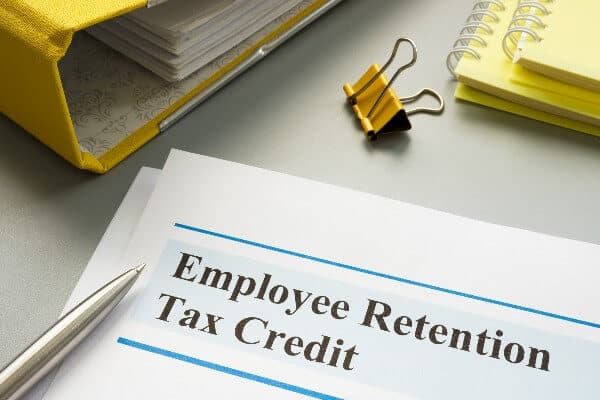The Employee Retention Credit (ERC) is a tax credit that can be refunded to businesses as part of the COVID-19 alleviation measures. The purpose of the credit is to ensure that affected businesses can continue paying their employees despite the effects of the pandemic. In these challenging economic times, the ERC has proven to be an invaluable resource for qualifying employers by providing them with financial relief. However, the ERC’s qualifying rules can be difficult to decipher, so it’s possible that businesses will want to consult an expert to make sure they qualify and reap the program’s full benefits. This article will explain who can claim the Employee Retention Credit, what qualifications they must meet, and what restrictions and caveats should be kept in mind.
What is Employee Retention Credit?
The Employee Retention Credit (ERC) is a tax credit aimed at supporting employers in retaining their employees during the COVID-19 pandemic. This credit is available to eligible employers who have faced significant revenue declines due to the pandemic. The ERC is a refundable credit, meaning that any excess amount above the tax owed will be refunded to the employer.
The ERC was introduced through the CARES Act in March 2020 and has since been extended and modified by subsequent legislation to cover the first two quarters of 2021. To claim the ERC, eligible employers must submit Form 941 with their quarterly employment tax returns. The credit can be used to offset the employer’s share of Social Security tax, Medicare tax, and federal income tax withholding.
The ERC is determined by taking a percentage of the total amount of qualified wages paid to employees in the relevant quarter. For the first two quarters of 2021, each employee is eligible for a credit of up to $7,000, which is 70% of their qualified wages. In other words, for the first two quarters of 2021, businesses can get a credit of up to $14,000 per worker.
Overall, the ERC is a valuable resource for eligible employers affected by the pandemic, helping them to maintain their workforce. The credit is available for up to $14,000 per employee for the first two quarters of 2021 and is a refundable credit, which means that employers may receive a refund if the credit amount exceeds their tax liability.
Eligibility Criteria for Employee Retention Credit
Meeting certain eligibility criteria is essential for employers who want to claim the Employee Retention Credit (ERC). The ERC aims to assist employers impacted by the COVID-19 pandemic and to ensure that the credit targets the right employers, certain criteria have been established.
Firstly, employers must have either fully or partially suspended their business operations during the relevant quarter or experienced a significant decline in revenue as a result of the pandemic. To be eligible for the ERC, revenue decline must have been at least 20% for the first two quarters of 2021 compared to the same quarter in 2019. For the third and fourth quarters of 2020, the revenue decline must be at least 50% compared to the same quarter in 2019.
Secondly, the ERC is only available to private-sector employers and tax-exempt organizations. Public sector employers are not eligible for this credit.
Thirdly, businesses must have paid their employee’s qualified pay during the relevant quarter. Qualified wages are defined differently for companies of different sizes. All wages paid during the qualifying period by employers with 500 or fewer employees are counted as qualified wages. Employers with more than 500 workers can only deduct wages paid to workers who were not delivering services due to a whole or partial cessation of business activities or a considerable drop in revenue.
Lastly, employers must provide evidence demonstrating that they meet the eligibility criteria for the ERC. This could include documentation or other forms of evidence.
How to Claim Employee Retention Credit
Claiming ERC involves several steps that employers need to follow. To claim the ERC, eligible employers must complete and submit Form 941, the employer’s quarterly federal tax return, to the IRS.
Here are the steps that employers can follow to claim the ERC:
- Determine eligibility: Before claiming the ERC, employers must ensure that they meet the eligibility criteria. The eligibility criteria have been outlined in previous sections of this article.
- Identify eligible quarters: Eligible employers can claim the ERC for qualified wages paid between March 13, 2020, and December 31, 2021. Employers must identify which quarters are eligible for the ERC based on the eligibility criteria.
- Calculate the ERC: The ERC is determined as a percentage of the employees’ qualified salaries for the qualifying quarters. For the first two quarters of 2021, each employee is eligible for a credit of up to $7,000, which is 70% of their qualified wages. In other words, for the first two quarters of 2021, businesses can get a credit of up to $14,000 per worker.
- Complete Form 941: To claim the ERC, eligible employers must complete Form 941 and include the ERC amount on Line 11c of the form. Employers should ensure that they have accurately calculated the ERC amount and that they have provided all required information on Form 941.
- Submit Form 941: Employers must submit Form 941 for each eligible quarter. The deadline for submitting Form 941 is the last day of the month following the end of the quarter. For example, the deadline for submitting Form 941 for the first quarter of 2021 is April 30, 2021.
- Claim any excess credit: If the ERC amount exceeds the employer’s total federal employment tax liability, the excess amount will be refunded to the employer. This refund will be sent to the employer in the form of a check or direct deposit.
Limitations and Considerations
While ERC can be a valuable source of financial relief for eligible employers, there are some limitations and considerations to keep in mind.
Firstly, employers cannot claim the ERC for the same wages that they used to claim the Paycheck Protection Program (PPP) loan forgiveness. This means that if an employer used PPP funds to pay employee wages, they cannot claim the ERC for those same wages.
Secondly, the ERC cannot be claimed for wages paid to family members of the business owner, except for certain family members who meet specific criteria.
Thirdly, employers cannot claim the ERC for wages paid to employees who were not providing services due to paid time off, including sick leave or vacation. This is because these wages are already eligible for tax credits under the Families First Coronavirus Response Act (FFCRA).
Lastly, the ERC may be subject to additional considerations based on the employer’s specific circumstances. For example, if an employer is in bankruptcy proceedings, they may not be eligible to claim the ERC.
It’s essential for employers to carefully consider these limitations and other factors before claiming the ERC to avoid any penalties or liabilities.
Conclusion
While the Employee Retention Credit (ERC) can be a huge boon to the bottom line for qualifying businesses, it’s important to remember the caveats and factors we discussed above. To verify their eligibility for the ERC and to avoid any potential penalties or obligations, employers should assess their situation and obtain professional assistance. Overall, ERC is a useful tool that should be used whenever possible to help firms retain personnel during tough times.
Related Articles
- RETENTION: Meaning, Rate, Credit Tax & Guide
- RECOVERY STARTUP BUSINESS ERC: Definition & How To Qualify
- RECESSION: What It Means, Examples & What to Do During Recession
- RETENTION RATE: What Is It, Formula, How to Calculate It & Difference
- CUSTOMER RETENTION: Definition, Strategies, Rate, Formulae & Importance






